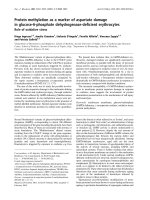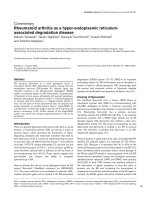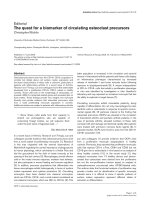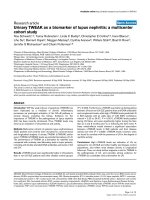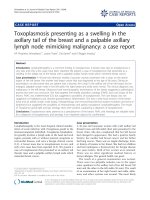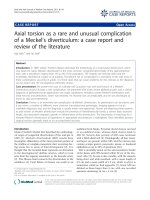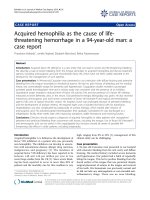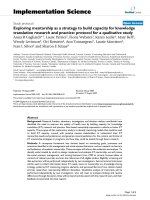Báo cáo y học: "Plasma gelsolin as a biomarker of inflammation" doc
Bạn đang xem bản rút gọn của tài liệu. Xem và tải ngay bản đầy đủ của tài liệu tại đây (38.8 KB, 2 trang )
Page 1 of 2
(page number not for citation purposes)
Available online />Abstract
The prognostic implications of declining plasma gelsolin levels
have been documented after a diverse variety of acute insults.
Because gelsolin concentrations fall prior to the development of
complications, a pathophysiological role for gelsolin depletion has
been postulated in delayed multiorgan failure. The original hypo-
thesis about the function of circulating gelsolin was that it
scavenged actin released from cells at the site of injury. Although
extracellular actin may be the primary cause of gelsolin depletion,
the biologic imperative for gelsolin could entail the modulation of
several inflammatory mediators as much as the disposal of actin.
Translational research is actively addressing whether replenish-
ment of plasma gelsolin could provide an efficacious and well
tolerated therapeutic intervention in selected seriously ill patients.
Osborn and colleagues demonstrate that patients with
rheumatoid arthritis and knee effusions have plasma gelsolin
levels lower than those in healthy volunteers [1]. Gelsolin was
first identified as a cytoplasmic actin-regulatory protein
essential for cell locomotion and phagocytosis. When a
circulating isoform was subsequently discovered, its physio-
logical significance was far from apparent.
For over two decades, researchers have struggled to define
the raison d’être for actin-binding proteins in plasma, which
under normal circumstances does not contain detectable
actin. A straightforward hypothesis emerged that plasma
gelsolin scavenges actin leaked into the circulation or
interstitial space from injured tissue in order to abort
subsequent damage instigated by extracellular actin filaments
[2]. Hypogelsolinemia ensues after a wide spectrum of
seemingly unrelated types of insults and precedes a second
wave of injury that typically involves organs distant from the
precipitating event [2-5]. The accumulated phenomenology
has given way to plausible mechanisms, but rigorous science
has yet to fully catch up with vigorous speculation.
Current dogma has expanded to now accommodate the
convincing observations that plasma gelsolin can bind a
variety of potentially inflammatory moieties, and can thereby
modulate the exuberance of the host response to sepsis,
malaria, burns, trauma, and other commonly encountered
clinical conditions. Plasma gelsolin’s primary function may be
to protect seriously ill patients from their own overzealous
inflammatory response. Identified ligands include platelet-
activating factor, lysophosphatidic acid, and sphingosine 1
phosphate, as well as cell-wall constituents of Gram-negative
and Gram-positive bacteria [6-8]. Actin exposed at the site of
overwhelming injury may act as a sink to exhaust the supply of
plasma gelsolin, in turn allowing redundant inflammatory
cascades unfettered opportunity to wreak havoc upon
multiple organ systems.
The lower the levels of plasma gelsolin, the less favorable the
prognosis of acute illness becomes [2-5,9]. Animal models
further indicate that exogenous gelsolin administered during
an identifiable window of opportunity can reduce injury and
lower mortality [9-11]. More recently, evidence has begun to
accumulate in chronic diseases. The current report by
Osborn and colleagues provides data on patients with
rheumatoid arthritis indicating that, at least in an acute-or-
chronic circumstance, circulating gelsolin concentrations are
depressed below the normal range [1]. Further, the authors
document the presence of gelsolin–actin complexes in
synovial fluid. The identification of gelsolin–actin complexes
inside the joint space is strong presumptive evidence of the
sequestration hypothesis, as long as the isoform associated
with the complexes is plasma gelsolin.
Rheumatoid arthritis represents a chronic inflammatory state
punctuated by episodes of acute synovitis. Kulakowska and
colleagues have recently demonstrated that blood and
cerebrospinal fluid gelsolin concentrations in patients with
multiple sclerosis are lower than levels for patients with
peripheral neurological disorders [12]. In their patients,
intrathecal actin was not detectable. The participants were all
considered to be in the early stages of relapsing–remitting
Editorial
Plasma gelsolin as a biomarker of inflammation
Mark J DiNubile
Division of Vaccines/Infectious Diseases, Medical Communications Department, Merck Research Laboratories, PO Box 1000, UG3C-06,
North Wales, PA 19454-1099, USA
Corresponding author: Mark J DiNubile,
Published: 3 December 2008 Arthritis Research & Therapy 2008, 10:124 (doi:10.1186/ar2547)
This article is online at />© 2008 BioMed Central Ltd
See related research article by Osborn et al., />Page 2 of 2
(page number not for citation purposes)
Arthritis Research & Therapy Vol 10 No 6 DiNubile
multiple sclerosis. Whether the chronic disease or an acute
flare is responsible for lowering gelsolin levels can be hard to
dissect in the setting of waxing and waning illness. Both
aspects of such disease entities can increase consumption as
well as restrain production of plasma proteins such as gelsolin.
Translational research in this area is also being optimistically
pursued. Inhalational use of recombinant human gelsolin
potentates the bactericidal activity of cationic endogenous
antimicrobial peptides and exogenous antibiotics. In fact,
gelsolin was first investigated as an inhaled therapeutic agent
to decrease the viscosity of airway secretions from patients
with cystic fibrosis. Appropriately dosed infusions of
recombinant human gelsolin can diminish evolving injury or
reduce mortality rates in animal models of hyperoxia, burns,
and sepsis [9-11]. A particular advantage of gelsolin therapy
over previously failed immunomodulary therapies derives from
its modulation of multiple proinflammatory pathways. Gelsolin
also inhibits certain actions of bacterial endotoxin. Gelsolin
repletion to physiological levels between the time of the initial
insult and subsequent complications in patients identified by
marked hypogelsolinemia as being at substantial risk for
delayed multiorgan dysfunction could provide a directed and
effective therapeutic intervention in critically ill patients.
Competing interests
Although MJD currently has no financial connection to any
company developing gelsolin for diagnostic or therapeutic
uses, he did receive consulting fees more than 5 years ago
from Biogen, which was studying the inhalational adminis-
tration of recombinant human gelsolin to patients with cystic
fibrosis. More recently, MJD has been an informal and unpaid
advisor to Critical Biologics Corporation, which has acquired
the rights to gelsolin. MJD is presently an employee of Merck
& Co., Inc., which has no current ties to gelsolin or Critical
Biologics Corporation.
Acknowledgement
The author is indebted to Joann DiLullo for her indispensable assistance.
References
1. Osborn TM, Verdrengh M, Stossel TP, Tarkowski A, Bokarewa M:
Decreased levels of the gelsolin plasma isoform in patients
with rheumatoid arthritis. Arthritis Res Ther 2008, 10:R117.
2. Lee WM, Galbraith RM: The extracellular actin-scavenger
system and actin toxicity. N Engl J Med 1992, 326:1335-1341.
3. Mounzer KC, Moncure M, Smith YR, DiNubile MJ: Relationship of
admission plasma gelsolin levels to clinical outcomes in
patients after major trauma. Am J Respir Crit Care Med 1999,
160:1673-1681.
4. DiNubile MJ, Stossel TP, Ljunghusen OC, Ferrara JL, Antin JH:
Prognostic implications of declining plasma gelsolin levels
after allogeneic stem cell transplantation. Blood 2002, 100:
4367-4371.
5. Lee PF, Drager LR, Stossel TP, Moore FD, Rogers SO: Relation-
ship of plasma gelsolin levels in outcomes of critically ill sur-
gical patients. Ann Surg 2006, 243:399-403.
6. Osborn TM, Dahlgren C, Hartwig JH, Stossel TP: Modifications
of cellular responses to lysophosphatidic acid and platelet
activating factor by plasma gelsolin. Am J Physiol Cell Physiol
2007, 292:C1323-C1330.
7. Bucki R, Georges PC, Espinassous Q, Funaki M, Pastore JJ,
Chaby R, Janmey PA: Inactivation of endotoxin by human
plasma gelsolin. Biochemistry 2005, 44:9590-9597.
8. Bucki R, Byfield FJ, Kulakowska A, McCormick ME, Drozdowski
W, Bucki R, Namiot Z, Hartung T, Janmey PA: Extracellular gel-
solin binds lipoteichoic acid and modulates cellular response
to proinflammatory bacterial wall components. J Immumol
2008, 181:4936-4944.
9. Lee PS, Waxman AB, Cotich KL, Chung SW, Perrella MA,
Stossel TP: Plasma gelsolin is a marker and therapeutic agent
in animal sepsis. Crit Care Med 2007, 35:849-855.
10. Christofidou-Solomidou C, Scherpereel A, Solomides CC,
Christie JD, Stossel TP, Goetz S, DiNubile MJ: Recombinant
plasma gelsolin diminishes the acute inflammatory response
to hyperoxia in mice. J Investig Med 2002, 50:54-60.
11. Rothenbach PA, Dahl B, Schwartz JJ, O’Keefe GE, Yamamoto M,
Lee MW, Horton JW, Yin HL, Turnage RH: Recombinant plasma
gelsolin infusion attenuates burn-induced pulmonary
microvascular dysfunction. J Appl Physiol 2004, 96:25-31.
12. Kulakowska A, Drozdowski W, Sadzynski A, Bucki R, Janmey PA:
Gelsolin concentration in cerebrospinal fluid from patients
with multiple sclerosis and other neurological disorders. Eur J
Neurol 2008, 15:584-588.
